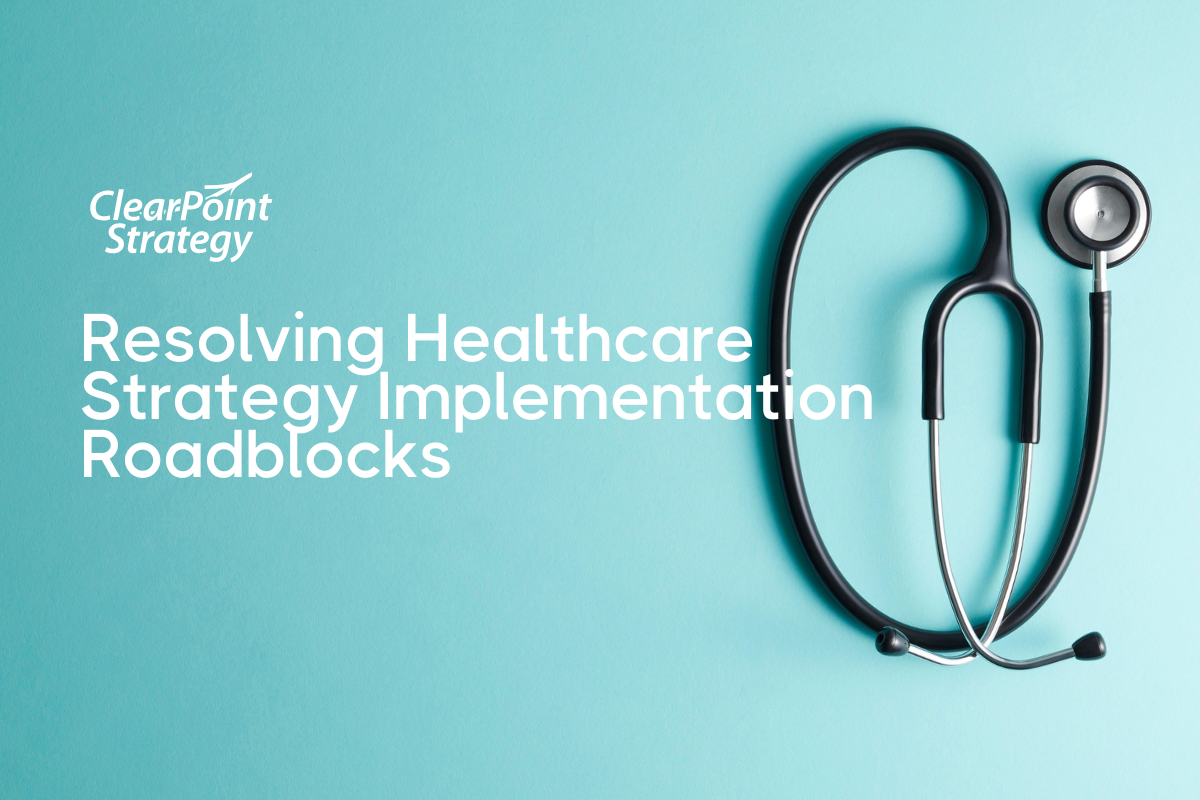Healthcare organizations work hard to provide quality care while managing budgets, staff, operations, and patient outcomes.
Healthcare organizations work hard to provide quality care while managing budgets, staff, operations, and patient outcomes. Behind the scenes, strong strategic planning holds all the moving parts together. A healthcare strategy helps leadership stay focused on goals like improving patient experience, meeting compliance standards, and supporting long-term growth. Without it, big-picture decisions become guesswork and progress can stall.
Still, having a solid strategy is just step one. Actually putting that strategy into action is where things often get stuck. Many healthcare leaders run into delays, communication gaps, or misaligned priorities that slow down or even derail implementation. The good news is, these challenges can be fixed. The key is knowing what’s standing in the way and having a clear plan to move forward.
Identifying Roadblocks In Healthcare Strategy Implementation
A strong strategy won’t make a difference unless it’s carried through each level of the organization. Here are some of the common trouble spots that slow things down:
1. Lack of Clear Objectives and Goals
If the objectives aren’t specific or easy to measure, teams can end up pulling in different directions. Vague goals like "improve quality" don’t give staff a clear path or accountability. For example, saying “reduce patient readmission rates by 10% in 12 months” is easier to act on than something general like “increase efficiency.”
2. Insufficient Communication and Collaboration
Departments often focus on their own day-to-day tasks without seeing how their work contributes to the bigger picture. Leadership might assume goals have been communicated, but without clear follow-up and check-ins, those goals may never be fully understood by staff. This creates a disconnect between strategy and operations.
3. Resistance to Change
Even when leadership is ready to make a shift, there’s often pushback from other levels in the organization. People get used to certain processes, and switching systems or restructuring workflows can feel risky. The lack of trust or fear of the unknown can stall progress.
4. Limited Resources and Budget Constraints
Healthcare teams are already spread thin. Adding strategic initiatives on top of daily operations often requires investments in time, training, and tools. When the budget is tight and staff are working at full capacity, implementation tends to fall to the bottom of the priority list.
Each of these issues chips away at strategy execution. The impact may not show up right away, but over time, delays turn into setbacks and missed opportunities. The next step is knowing how to fix the most common failures and make strategy part of daily practice.
Strategies to Overcome Healthcare Strategy Implementation Roadblocks
Once you understand the common roadblocks, the next step is putting measures in place to overcome them. Here are a few ways to effectively push past these challenges:
- Set Clear and Measurable Goals: Start by defining specific results you want to achieve. If a goal is to improve patient satisfaction, clarify what aspect of satisfaction you’re aiming to enhance. Is it about reducing wait times or improving communication about care plans? Specificity helps keep efforts aligned and trackable.
- Enhance Communication and Collaboration: Foster an environment where communication flows freely and collaboration is encouraged across departments. Regular meetings, shared platforms for updates, and open forums for feedback all help everyone stay on the same page. When people understand both how and why certain strategies are important, they’re more likely to contribute positively.
- Foster a Culture of Adaptability and Change: It’s important to build a workplace climate that supports flexibility. Recognize team efforts and improvements in changing workflows, which can help reduce resistance. Share wins within the organization to highlight how recent changes have made work easier or improved care. Celebrating what’s working can get more people behind the strategy.
- Allocate Resources and Budget Efficiently: Carefully assess available time, people, and funds. Don’t stretch teams too thin. Prioritize strategic projects and dedicate adequate support. Provide training when needed so that staff have the skills and confidence to carry out plans. Don’t let a lack of resources stall good ideas—plan for what’s realistic and impactful.
These small but focused steps can make tough problems less intimidating. When teams understand the direction, feel supported, and see progress, strategy becomes a part of routine operations instead of something extra.
The Role of a Platform for Healthcare Strategy
Turning a strategy from a document into real action is hard to do manually, especially in fast-paced healthcare settings. A dedicated platform helps make the process more manageable by connecting everyday work to larger goals.
- Integrate Strategic Planning: A platform links strategy with ongoing operations in a way that allows leadership and team members to understand where their efforts fit. It gives a full view of how departments are performing in connection with broader organizational targets.
- Real-Time Tracking and Reporting: With ongoing updates, it’s easier to spot where progress is being made or where things might need attention. Instead of waiting for monthly reports or meetings, decision-makers can take action when it matters most.
- Enhance Decision-Making Processes: One of the biggest challenges leaders face is having too much disconnected or outdated information. A platform organizes data in one place, making it easier to pinpoint problems, act quickly, and stay aligned with goals.
- Ensure Compliance and Quality Standards: Healthcare regulations change frequently. A platform makes it easier to monitor organizational benchmarks, quality improvements, and compliance updates in real time. This reduces the risk of falling behind on standards or overlooking key reporting duties.
A platform doesn’t replace people, but it does make their jobs easier. It offers structure and clarity, something that can be hard to maintain when juggling regulatory pressure, long shifts, and complex workflows.
How ClearPoint Strategy Can Help
ClearPoint Strategy’s platform gives healthcare organizations the tools to close the gap between planning and doing. Unlike one-size-fits-all options, the platform is designed with strategy execution in mind. It helps teams track performance, update stakeholders, and break big goals into manageable tasks.
Need to align multiple departments with one unified objective? ClearPoint allows you to set measurable goals, assign ownership, and automate updates to keep everyone informed without additional meetings. Facing communication issues? The platform centralizes updates and progress reports, so there’s no need to chase down information when decisions need to be made.
Hospitals and healthcare systems that have used ClearPoint have seen improved follow-through on key initiatives ranging from enhancing patient safety to improving operational workflows. With everything in one place, leaders can spend more time guiding and less time gathering scattered data.
ClearPoint also supports compliance by keeping track of quality measures, internal audits, and regulatory updates. This is especially helpful for organizations that need to meet state and federal standards consistently while handling other strategic changes.
By bringing structure and visibility to healthcare strategy, ClearPoint removes the guesswork and helps your organization stay focused on what matters most—delivering better outcomes, sustaining growth, and making sure daily actions reflect long-term plans.
Where Do You Want Your Healthcare Strategy to Go?
Now that you’ve seen the common issues that make strategy fall short, and how to resolve them, the next move is up to you. Strategy only makes an impact when it turns into daily action. That means setting specific targets, making sure your team understands the plan, giving them the tools to deliver, and checking progress frequently.
If you’re tired of watching good plans stall or big goals get pushed aside, it’s time to rethink how you manage strategy. A simple, reliable platform could be the tipping point that helps your healthcare organization stay ahead.
For healthcare organizations aiming to bridge the gap between planning and execution, having the right tools can make a meaningful difference. Explore how ClearPoint Strategy can support your goals with a powerful platform for healthcare strategy that connects your initiatives to measurable outcomes, improves collaboration, and keeps your team aligned every step of the way.

.svg)



![How To Do Strategy Execution Like The Top 1% [DATA]](https://cdn.prod.website-files.com/637e14518f6e3b2a5c392294/6943dc61ad7ba3aa1e7a00ae_how-to-do-strategy-execution-like-the-top-data-blog-header.webp)
![How Often Are Strategic Initiatives Completed? [DATA]](https://cdn.prod.website-files.com/637e14518f6e3b2a5c392294/694081943dbced2358f47d83_how-often-are-strategic-initiatives-completed-data-blog-header.webp)